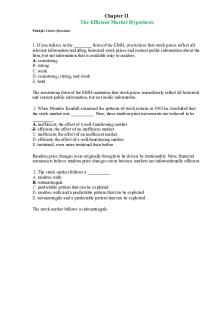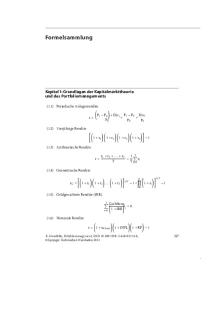Efficient Market Hypothesis PDF

| Title | Efficient Market Hypothesis |
|---|---|
| Course | Asset Pricing |
| Institution | University of Bristol |
| Pages | 5 |
| File Size | 119.6 KB |
| File Type | |
| Total Downloads | 59 |
| Total Views | 128 |
Summary
Formative Assignment for Asset Pricing on Efficient Market Hypothesis...
Description
Compare and contrast the Efficient Market Hypothesis (EMH) and Behavioural Finance (BF) theories. What are the implications of EMH and BF for investment analysts?
ECONM2035 Asset Pricing Professor Evarist Stoja University of Bristol 1st December, 2017
1
I.
Introduction Efficient Market Hypothesis (EMH) and Behavioral Finance (BF) are two strikingly different theories in academic studies of financial market but both theories are influential to the studies of Finance. In terms of trading, Efficient Market Hypothesis (EMH) is a theory of the “ rationalities”of the financial market, with an assumption that all investors (or at least some of the investors) are rational and will trade speculative assets to their prices which reflect categories of information, depends on how efficient the market is. The most optimal form of efficient market –Strong Form Efficient Market (SFEM) hav easset prices “ fully reflect”all the possible (or best) information (Fama and Malkiel, 1970), thus investors could not benefit from trading on previous released information. On the other hand, Behavioral Finance (BF) is a theory of the irrationalities of the financial market which challenge that information are fairly reflected in asset prices by incorporating psychological limitations of human beings, however, it does not imply that there is opportunity to make profit by trading on information. Efficient Market Hypothesis (EMH) lays down the cornerstone for a lot of financial theories as those theories require the market is efficient to hold, such as Modigliani and Miller Theorem in Corporate Finance. However, we know that the world is not always as ideal as what theories stated, which in turns gives rise of the Behavioral Finance (BF) theory, as it could be easier for people to accept the fact that human has limitations and flaws than to believe the perfect world of efficient market really exist. Instead of repeating both the theories again, this paper is going to contrast aforementioned theories and to evaluate their implications for investment analysts.
II.
Contrasting Efficient Market Hypothesis (EMH) and Behavioral Finance (BF) Barberis and Thaler (2003) described “ limit to arbitrage”and “ psychology”are two building blocks of Behavioral Finance (BF). Traditional finance theories such as Efficient Market Hypothesis (EMH) based on “ no limit to arbitrage”and “ rationality”in contrast to “ limit to arbitrage”and “ psychology” . These building blocks can be the starting points of contrasting Efficient Market Hypothesis (EMH) and Behavioural Finance (BF). Efficient Market Hypothesis (EMH) stated that an efficient market would have asset prices fully reflected by all possible information, but it does not require all investors to be absolutely rational. However, if there is an irrational investor or less rational investor trading in the market, it is possible that the asset prices will deviate from what the ones that fully and fairly reflect existing information. If to make Efficient Market Hypothesis (EMH) holds, “ no limit to arbitrage”would be an important assumption as arbitrage opportunity is a mechanism used by rational investors to adjust the asset prices back to a level that that fully and fairly reflect existing information in Efficient Market Hypothesis (EMH). Any limitation to arbitrage, such as limitation of taking a short position due to lack of assets for borrowing, or transaction or implementation costs of arbitrage opportunities will prevent rational investors to attempt trading the asset back to the price that fully and fairly reflect existing information.
2
“ Limit to arbitrage”as a building block of Behavioral Finance (BF), it challenges Efficient Market Hypothesis (EMH) by giving evidence that financial markets could be less operational efficient and thus less informational efficient due to limit to arbitrage. Barberis and Thaler (2003) has given example in their paper that rational investors would find undervalued assets inexpensive and thus to make profit by taking a long position of those assets and which will eventually make those assets less inexpensive with their buying pressure. However, it is a different story for overvalued assets. Miller (1977) pointed out that lack of arbitrage would make asset prices only reflect bullish investors perception becuase taking a short position by borrowing that asset to short sell is not always possible due to unavailability of that asset or implementation cost. Therefore, it may be sensible to think that there is limit to arbitrage in the real financial world. In the previous discussion of “ no limit to arbitrage”assumption of Efficient Market Hypothesis (EMH), it is always assumed that there is at least one very rational investor who will correct the price deviations made by other less rational investors. Even if there is really no limit to arbitrage, there has to be a rational investor to implement the arbitrage. “ Rationality”assumption of Efficient Market Hypothesis (EMH) assumed that there exist those rational investors “ make decisions according to the axioms of expected utility theory” and “ makes unbiased forecasts about the future”(Thaler, 1999). In simpler words, even if there is really no limit to arbitrage, there must be some rational investors who could process new information and update those information to asset prices fairly and correctly through trading activities in order to make Efficient Market Hypothesis (EMH) holds. Therefore, “ rationality”is an important condition for Efficient Market Hypothesis (EMH) to hold. “ Psychology”as opposed to “ Rationality” , is the second building block of Behavorial Finance (BF). “ Psychology”does not mean “ irrationality”but it provides explanation of why human beings are biased to information and thus make irrational investment decisions. Barberis and Thaler (2003) specifically conclude that irrational investment decisions could be caused by biases occur when people form their beliefs on their preferences. These theories prevent people from being investors who are absolutely rational, and thus Behavioral Finance (BF) suggest asset prices in financial market may not be always reflecting all possible information correctly, because there could be no such always “ rational”investors who are able to process all information and update the asset prices in the financial markets through trading. III.
Implications of Efficient Market Hypothesis (EMH) and Behavioral Finance (BF) for investment analysts Three forms of Efficient Market Hypothesis (EMH) pointed out that predicting future price trends with historical prices, fundamental analysis and technical analysis is not useful for generating profit, as all information should all have been incorporated in the asset prices. One important implication of this for investment analysts is that passive investment could be better than active investment. It is because that if Efficient Market Hypothesis (EMH) holds, it is by theory impossible for investors to beat the market continuously as they could not predict the future trends. For instance, Sharpe (1991) concluded that passively managed 3
investment outperformed actively managed investment on average if “ properly measured” . Investing in passively managed index funds could be a better strategy, if Efficient Market Hypothesis (EMH) holds. Behavioural Finance (BF) put an emphasis on human psychology and tried to explain anomalies in the market with psychological limitation of human. Active investing could be profitable according to theorists of BF, but there are several implications to investment analysts if they aimed to make optimal decision: 1. Beliefs Barberis and Thaler (2003) summarized the causes of bias when investors forming expectation include overconfidence, optimism, representativeness, conservatism, belief perseverance, anchoring, and availability bias. Overconfidence and optimism majorly affect investors by making them engaging trading activities more frequently. In addition to that, it may affect their ability of diversification as they may be overconfident on several stocks that they picked. To avoid these problems, investment analysts should be cautious about the weight the put on particular stocks and should diversify appropriately, which will eventually reduce costs by being less active. The remaining factors affect investment decisions by hindering investors ability of estimating probabilities of events or their ability to access information correctly. Barberis and Thaler (2003) pointed out that investment analysts may have sophisticated models. These models may contribute to the effect of the remaining factors mentioned as they tend to believe what the models suggest and failed to process information correctly when receiving new contradicting information. They may need to aware of those factors while using their models for investment analysis. 2. Preference The prospect theory suggested that people tend to perceive gain and loss differently, simplest way to put is that the degree of painfulness of losing tend to be higher than the degree of happiness of earning same amount of money. The major problems caused under this theory are that people tend to sell assets too early when the asset prices increase and tend to hold onto the assets for too long when the asset prices decrease. Investment analysts when analysing assets, should set up exit and profit strategies when losing or gaining in order to prevent losing too much or earning less than optimal amount. IV.
Conclusion This paper presented some comparisons and implications of Efficient Market Hypothesis (EMH) and Behavioral Finance (BF). However, it is worth to mention that both theories are controversial and there is no absolute strategy that could be recommended to investment
4
analysts for making profit by trading, because both of the theories have their drawbacks and evidence could be found for both theories through event studies. Nevertheless, these two theories will still give investment analysts some frameworks to retrospect their investment analysis. (1482 Words) V.
References Barberis, N. and Thaler, R., 2003. A survey of behavioral finance. Handbook of the Economics of Finance, 1, pp.1053-1128. Fama, E.F. and Malkiel, B.G., 1970. Efficient capital markets: A review of theory and empirical work. The journal of Finance, 25(2), pp.383-417. Miller, E.M., 1977. Risk, uncertainty, and divergence of opinion. The Journal of finance, 32(4), pp.1151-1168. Sharpe, W.F., 1991. The arithmetic of active management. Financial Analysts Journal, 47(1), pp.7-9. Thaler, R., 1999, “ The End of Behavioral Finance” , Financial Analysts Journal, vol. 55, no. 6.
5...
Similar Free PDFs

Efficient Market Hypothesis
- 5 Pages

Ch11 The Efficient Market Hypothesis
- 23 Pages

Organizational hypothesis
- 2 Pages

Input Hypothesis
- 10 Pages

Efficient Portfolios Using Solver
- 17 Pages

Formel + Efficient Frontier
- 42 Pages

Hypothesis Testing
- 3 Pages

Market & Market Failure
- 2 Pages

Hypothesis Lolita, Oscar, Verity
- 1 Pages

Hypothesis Testing Cheat Sheet
- 2 Pages
Popular Institutions
- Tinajero National High School - Annex
- Politeknik Caltex Riau
- Yokohama City University
- SGT University
- University of Al-Qadisiyah
- Divine Word College of Vigan
- Techniek College Rotterdam
- Universidade de Santiago
- Universiti Teknologi MARA Cawangan Johor Kampus Pasir Gudang
- Poltekkes Kemenkes Yogyakarta
- Baguio City National High School
- Colegio san marcos
- preparatoria uno
- Centro de Bachillerato Tecnológico Industrial y de Servicios No. 107
- Dalian Maritime University
- Quang Trung Secondary School
- Colegio Tecnológico en Informática
- Corporación Regional de Educación Superior
- Grupo CEDVA
- Dar Al Uloom University
- Centro de Estudios Preuniversitarios de la Universidad Nacional de Ingeniería
- 上智大学
- Aakash International School, Nuna Majara
- San Felipe Neri Catholic School
- Kang Chiao International School - New Taipei City
- Misamis Occidental National High School
- Institución Educativa Escuela Normal Juan Ladrilleros
- Kolehiyo ng Pantukan
- Batanes State College
- Instituto Continental
- Sekolah Menengah Kejuruan Kesehatan Kaltara (Tarakan)
- Colegio de La Inmaculada Concepcion - Cebu





